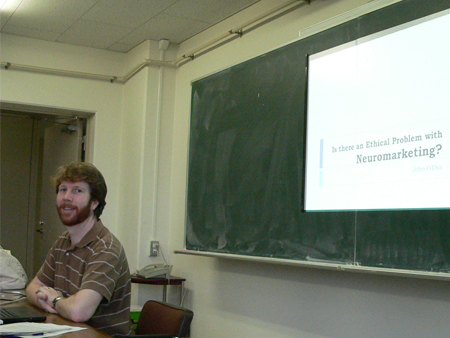Report: The 8th Tokyo Colloquium of Cognitive Philosophy (TCCP)
The Program of the 8th TCCP was a presentation by John O’Dea, a research fellow of UTCP. The title of his presentation was "Is there an Ethical Problem with Neuromarketing?" As indicated in the title, it was a review of the background and current state of Neuromarketing; i.e., the commercial use of neuroscientific knowledge or technology for the purpose of manipulating public opinion. Neuromarketing is one of hot topics within neuroethics, though there are not yet many neuroethical papers on neuromarketing. Assessing several studies on neural features of consumers and examples of actual commercial uses, O’Dea concludes that there’s no ethical problem with neuromarketing.

The review begins with history of neuromarketing. In 1950’s, there was a new trend for using scientific techniques for marketing. In the post-war American consumer boom, advertising flourished to form an industry. In need of effective techniques for persuading consumers, advertising firms began to appeal to science. Psychologists were hired by larger companies, and it was soon discovered that emotional factors influenced far more decisions in everyday life than been thought. It became the orthodox view that people often choose without being aware of the reason, for example they are motivated by unconscious emotions. After that, advertisements have become to be intended to elicit emotions rather than to convey information.
Neuromarketing arises within this trend of science-based marketing. The beginning of neuromarketing is an fMRI study by McClure and others[*1], which involved an fMRI scan of subjects drinking Coca-Cola or Pepsi. According to the authors, subjects showed preference for Coke to Pepsi only when they were informed what they were drinking. And under this informed condition, the hippocampus and dorsolateral prefrontal cortex―the regions thought to be involved in emotionally-biased decisions―showed activation only for Coke. It can be said that the experiment tells us that the popularity of Coke is generally not based on taste but rather on the emotion evoked by its brand image. Although it is a consistent result with current knowledge about consumer’s preference, it is not in the least a new discovery. Thus, there has been no clinical application of the findings of McClure et al. Before the Coke/Pepsi study, attempts to utilize neuroscience technologies for marketing had ended up unsuccessfully; they could not give an answer specific enough to take the place of existing methods. The Coke/Pepsi study seems to have gone the same way.
A question can then be posed: Is there a problem with neuromarketing? Gary Ruskin of the NGO “Commercial Alert” claims that there are such problems as increasing marketing-related disease, being used for political propaganda unfairly, and promoting degraded values such as materialism.[*2] However, there is no evidence that neuroscience itself lead to these outcomes.
The effectiveness neuroscience technologies can have on marketing seems to be exaggerated: but why? A study by McCabe and Castel[*3] gives a clue to this question. Their study shows that people tend to think research findings much more credible if presented along with fMRI images, even if those images add no information to the article.
Neuromarketing attracts attention also in the field of politics. However, we have little understandings of unconscious processes concerning decision-making, much less concerning political choice. Hence, very few studies on political thinking have been done[*4], and the existing results are too weak for the purpose of seeking a way to design effective propaganda. Here, a point made by Aldous Huxley is instructive. He argued that political propaganda is far more difficult to make than commercial propaganda, for the former concerns persuading people of the correctness of a policy, while in the latter case it is effective to appeal to factors entirely irrelevant to the product itself, e.g., the sex appeal of the girl on the poster.[*5] It seems that utilizing neuroscientific knowledge for political campaigns is much more difficult than for marketing.
The hormone called oxytocin might be seen as a typical case of the business use of neurotechnologies. Oxytocin is a hormone known for its involvement in maternal behavior and lactation in mammals. Recent studies reveal that oxytocin takes part in the formation of trusting relationships between humans; there are experimental results showing that if the presence of oxytocin in one’s brain is increased, trusting behavior is increased, too.[*6] Due to this finding, worries about improper uses of oxytocin are expressed in the popular media. However, we don’t have to be very concerned about this. Isolating oxytocin and using it to manipulate people is technically very difficult and much less effective than boosting oxytocin levels in the brain indirectly, i.e., by psychological techniques such as ordinary persuasion.
Through surveying the current situation of neuromarketing cited above, O’Dea concludes that no ethical problems concerning neuromarketing can occur yet, for there is no evidence to show that current neurotechnologies can be effective for marketing purpose.

I found O’Dea’s survey instructive, reviewing the latest studies and examples of neuromarketing. Neuroethics is a brand-new discipline. Hence, it is one of major questions in the discipline whether there really are ethical problems with neuroscience, and if there are, what are they like. O’Dea concludes that, at the moment, there are no ethical problems concerning neuromarketing. However, I suppose it may be a serious problem that explanations using neuroscientific data can affect consumers’ motivation, even if such explanations actually carry no additional information.
[*1] McClure, Samuel M., Jian Li, Damon Tomlin, Kim S. Cypert, Latané, M. Montague, and P. Read Montague, (2004), “Neural Correlates of Behavioral Preference for Culturally Familiar Drinks”, Neuron, Vol. 44, 379–387.
[*2] Ruskin, Gary, “Neuromarketing” http://www.commercialalert.org/issues/culture/neuromarketing; accessed 18/6/2008.
[*3] McCabe, D., Castel, A. (2008). “Seeing is believing: The effect of brain images on judgments of scientific reasoning”. Cognition, 107(1), 343-352.
[*4] For example, see Kaplan JT, Freedman J, Iacoboni M. (2007), “Us versus them: Political attitudes and party affiliation influence neural response to faces of presidential candidates”. Neuropsychologia 7;45(1):55-64; Marco Iacoboni, Joshua Freedman and Jonas Kaplan, “This Is Your Brain on Politics” The New York Times, November 11, 2007.
[*5] Huxley, Aldous (1962), “Notes on Propoganda”, Voice of the People: Readings in Public Opinion and Propaganda. Publisher: New York: McGraw-Hill. 1962; 325.
[*6] For example, see Baumgartner, Thomas, Markus Heinrichs, Aline Vonlanthen, Urs Fischbacher, and Ernst Fehr (2008), “Oxytocin Shapes the Neural Circuitry of Trust and Trust Adaptation in Humans” Neuron 58, Issue 4; 639-650; Kosfeld, M., Heinrichs, M., Zak, P.J. , Fischbacher, U. , Fehr, E. (2005), “Oxytocin Increases Trust in Humans”, Nature, Vol. 435, No. 2, pp. 673-676; p.673.
Haruka Tsutsui (The University of Tokyo)






